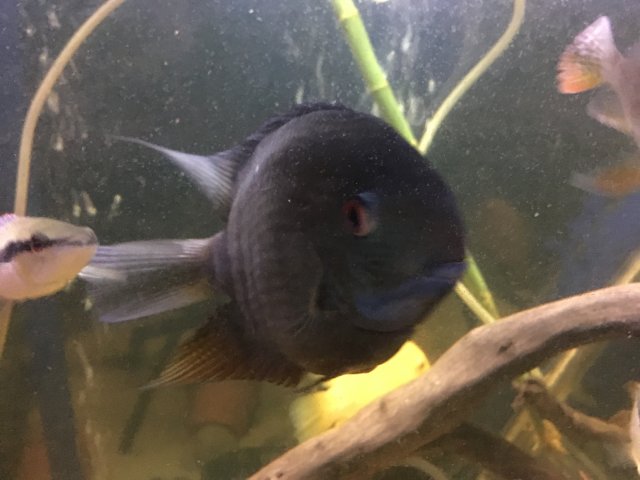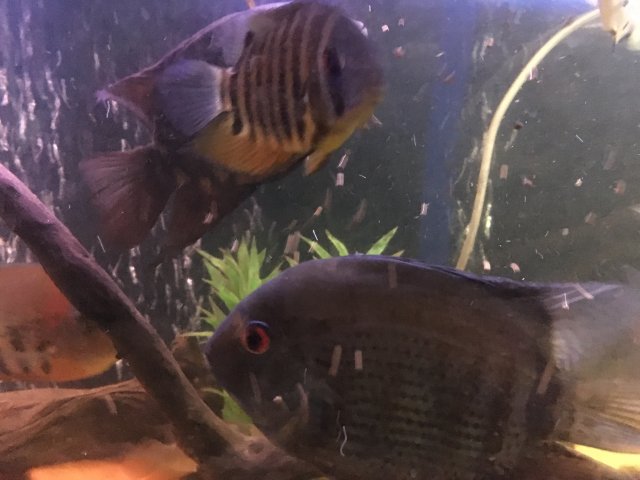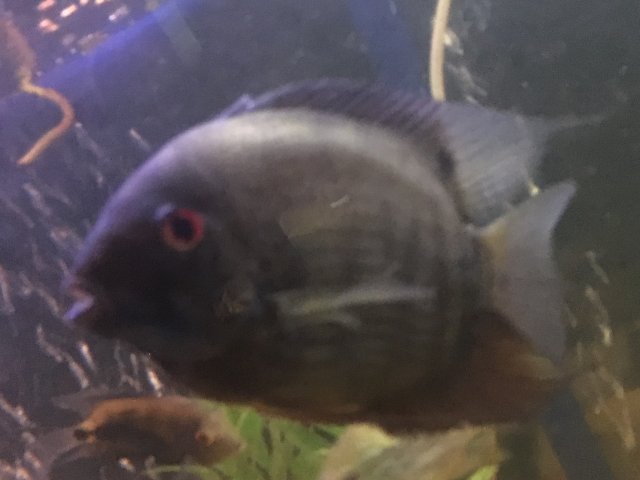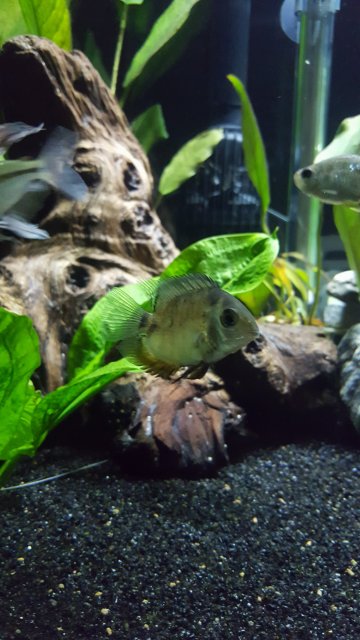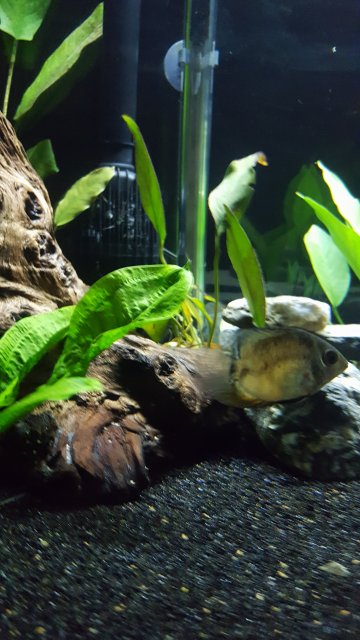I agree with pretty much everything posted, only thing I will add is I highly recommend the NLS Ultra Red formula. Try that for a few months and at least you can rule out diet. I've found it to be an excellent food for both color and growth. Personally I'm not a fan of Kens foods, but as others have stated this juvie might just be slow in showing his full potential. Good luck.
Rotkeil Severum
- Thread starter MattyV55
- Start date
Thanks neutrino-Hard to say without seeing them, but I've seen rotkeils called 'orange shoulder' before. Your description could be said of more than one type. Names can depend where you got it sometimes, not always correct or precise. I notice you're in Mass, I lived there in the 90s, don't know now, but at the time there were some high quality fish stores around, some that really knew their stuff.
Pretty safe to say that in my area very few people have heard of or seen rotkeil severums, it's pretty rural here
We still have uncle neds, perhaps the best on the east coast. My old haunt exotic fish and pet has closed to focus on pond maintenance and there is tropic isle which is good for very basic fish, saltwater and good equipment selection.
I have a group of cb rotkiels and a WC male that is the same size as the orange shoulder and they look nothing alike.
I’m guessing the orange shoulder is a variety of what used to be called apendactulus (spelling) or like a Rio negro efasciatus
It’s just an efasciatus. Orange shoulder, red shoulder, rotkeil, etc. are all names for the same fish. The seller you got this fish from simply had it mislabeled.
Hi Ryan this is my rotkiel in front of the orange shoulder. The rotkiel looks like this all the time. The efasciatus variety I had were much darker then either of these and had 9 bars.
I believe they represent the fish but front different collection points. However it seems rotkiels consistently grow to a smaller size than the efasciatus
---
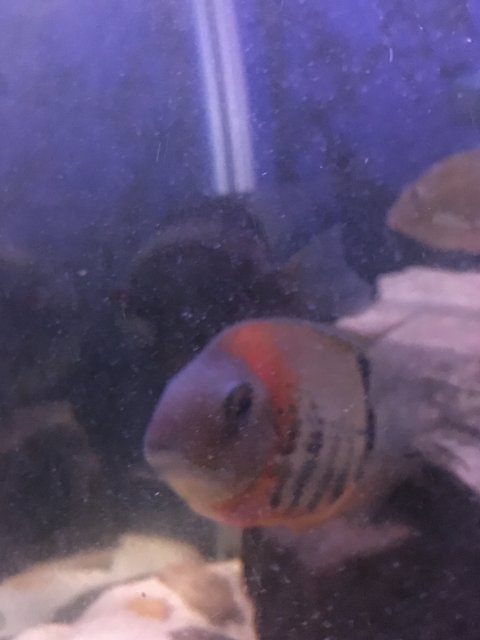
I believe they represent the fish but front different collection points. However it seems rotkiels consistently grow to a smaller size than the efasciatus
---

It is believed by some that rotkeils are not truly naturally occurring fish. They are from “Peru” but no collection point has ever been revealed and there is no documentation of them in the wild. Some theorize that appendiculatus from Peru were crossed with a lone male Heros severus imported to Germany over a decade ago, and those resulting hybrid fry were the origins of the rotkeil. These fish were then sold back to the importer to be pond-raised in and distributed from Peru. The first few generations of rotkeils were highly variable, and we still see that today. So even when we talk about “rotkeil” we are talking about a likely manmade fish that wildly varies between individuals.
Can you provide a source or sources? 'Believed by some' isn't that convincing when what I have seen, both in print and online sources, including translated international sources, has sp. rotkeil as being from Rio Nanay. I haven't seen everything but I've had a few hundred and they didn't vary much, no more than what's typical in a number of true species of fish I've had of known provenance, and I've seen even more and these didn't vary wildly.It is believed by some that rotkeils are not truly naturally occurring fish. They are from “Peru” but no collection point has ever been revealed and there is no documentation of them in the wild. Some theorize that appendiculatus from Peru were crossed with a lone male Heros severus imported to Germany over a decade ago, and those resulting hybrid fry were the origins of the rotkeil. These fish were then sold back to the importer to be pond-raised in and distributed from Peru. The first few generations of rotkeils were highly variable, and we still see that today. So even when we talk about “rotkeil” we are talking about a likely manmade fish that wildly varies between individuals.
I do a lot of university and science journal reading (and some writing) on certain science subjects, so I'm accustomed to checking sources, and if I know anything I know that there's more than a modicum of implied or stated science 'discoveries' or science 'fact' in the news and media that turn out to be unconfirmed speculation or theory, or a matter of debate or controversy among scientists themselves. So I'm open to reconsidering what rotkeils are or might be, but absent something more substantial I can't logically do much more than file it away as some reportedly question the origin of rotkeils, but I don't know their credentials and this contradicts what I've read over the years from multiple (non-forum post) sources.
If you have Facebook, get in touch with Peter Dittrich who has written a new book on Heros and was also responsible for re-classifying liberifer and properly identifying Heros severus. He and colleagues have traveled and collected extensively for years and none of them have been able to locate the fish in the wild. This, despite lots of “wilds” getting exported every year.
His DNA testing also showed that rotkeils fell on the tree exactly between severus and appendiculatus, despite one fish being from Peru and the other being in Venezuela/Colombia. The mitochondrial DNA (from the female) of appendiculatus and rotkeil are close.
We had a long, informative chat about it on a Heros group on Facebook but obviously I cannot link to that from a forum.
His DNA testing also showed that rotkeils fell on the tree exactly between severus and appendiculatus, despite one fish being from Peru and the other being in Venezuela/Colombia. The mitochondrial DNA (from the female) of appendiculatus and rotkeil are close.
We had a long, informative chat about it on a Heros group on Facebook but obviously I cannot link to that from a forum.
Last edited:
Exactly what I was looking for, will check it out, thanks.If you have Facebook, get in touch with Peter Dittrich who has written a new book on Heros and was also responsible for re-classifying liberifer and properly identifying Heros severus. He and colleagues have traveled and collected extensively for years and none of them have been able to locate the fish in the wild. This, despite lots of “wilds” getting exported every year.
His DNA testing also showed that rotkeils fell on the tree exactly between severus and appendiculatus, despite one fish being from Peru and the other being in Venezuela/Colombia. The mitochondrial DNA (from the female) of appendiculatus and rotkeil are close.
We had a long, informative chat about it on a Heros group on Facebook but obviously I cannot link to that from a forum.
So, I've had 'wild' rotkeils, have seen respected importers sell 'wild' rotkeils over the years. If the above is true, these are apparently being exported from Peru as wild? --unless they would eventually turn up in the wild somewhere, in which case I suppose you could still question the source of them,. as to whether they might be a natural wild hybrid or a man made-released into the wild hybrid.




